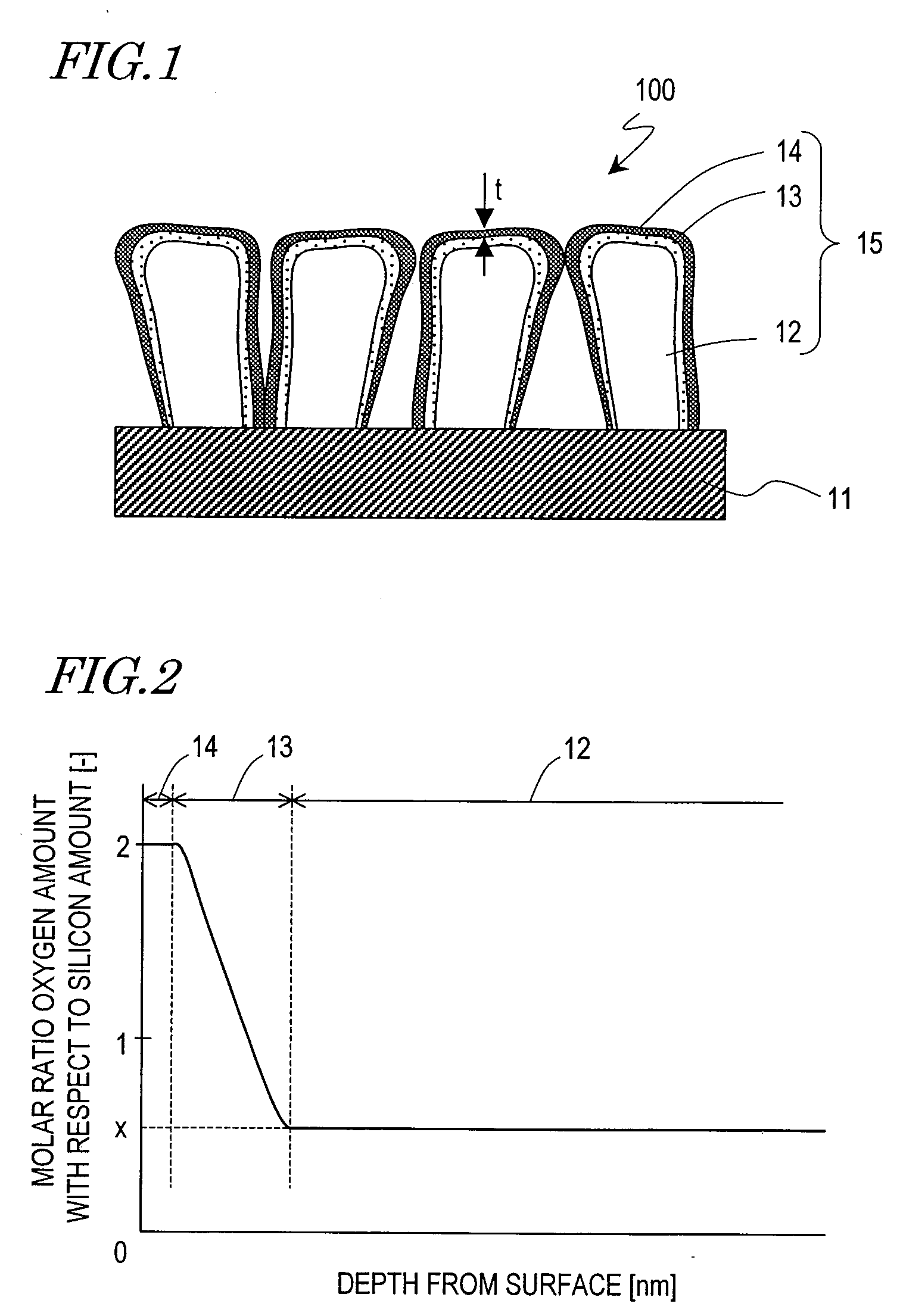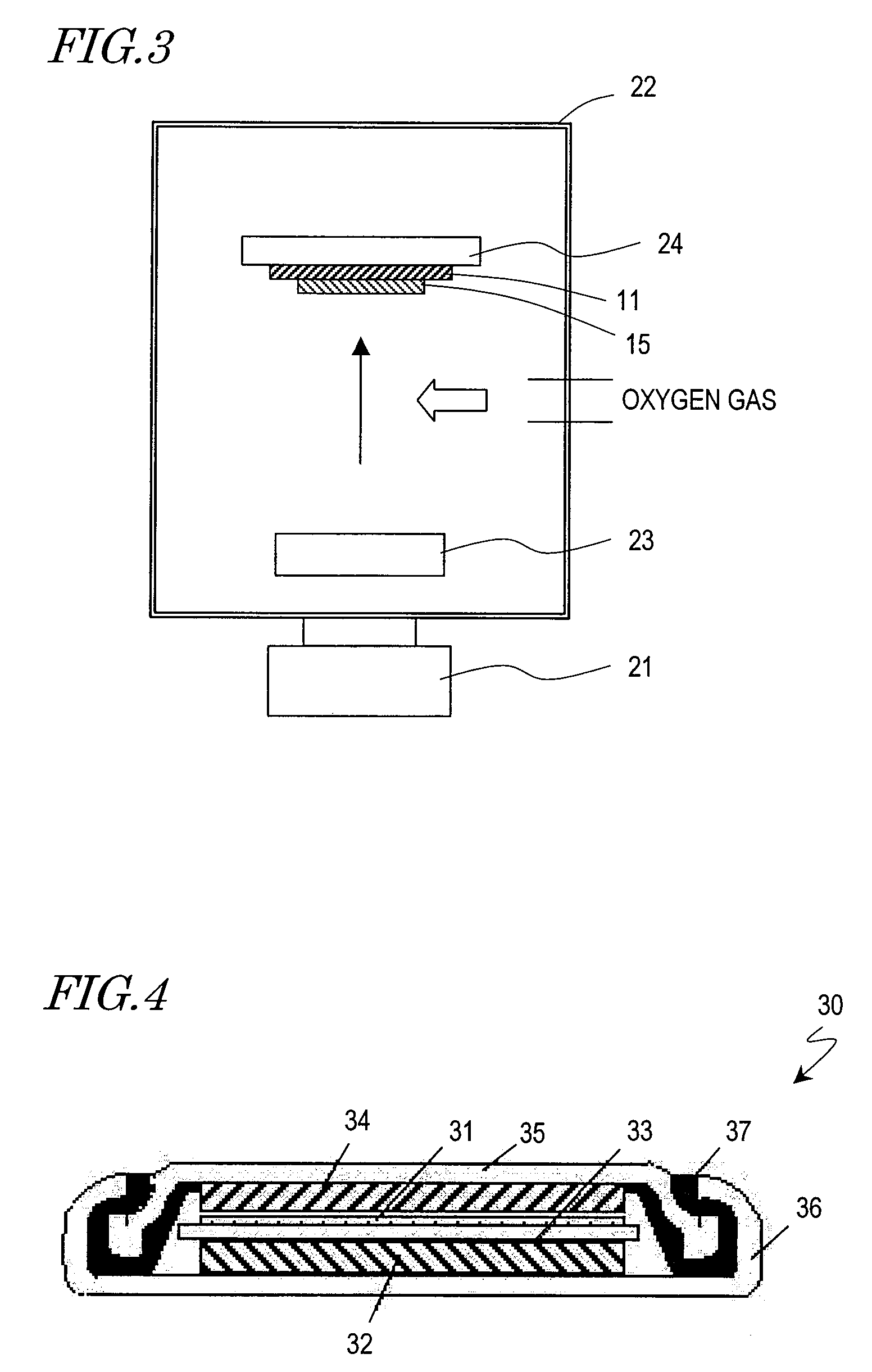Negative electrode for lithium secondary battery, method for producing same, and lithium secondary battery comprising such negative electrode for lithium secondary battery
a secondary battery and negative electrode technology, applied in the direction of electrochemical generators, cell components, cell component details, etc., can solve the problems of insufficient cycle characteristics, large volumetric change of silicon, and lower current collection ability, and achieve excellent charge-discharge cycle characteristics and high charge-discharge capacity
- Summary
- Abstract
- Description
- Claims
- Application Information
AI Technical Summary
Benefits of technology
Problems solved by technology
Method used
Image
Examples
example 1
1. Production of Negative-Electrode Active Material Layer
[0116]First, by using a production apparatus having the structure shown in FIG. 3, a negative-electrode active material layer was produced on the surface of a current collector. The production method will be specifically described.
[0117]In advance, silicon tablets (with a purity of 99.99% or more) were inserted in the carbon crucible 23, which was placed within the vacuum chamber 22, and after setting the pressure within the vacuum chamber 22 to 0.005 Pa, an oxygen gas was introduced at a flow rate of 70 sccm, and the pressure within the vacuum chamber 22 was set to 0.13 Pa.
[0118]Thereafter, under the conditions of voltage: −9 kV and EB current: 400 mA, an electron beam was radiated from the electron gun onto the aforementioned silicon tablets, thus allowing the silicon to melt and vapor-deposited onto the current collector 11, which was disposed so as to oppose the carbon crucible 23. As the current collector 11, a copper foi...
example 2
[0132]A negative-electrode active material layer and a coin battery of Example 2 were produced by methods similar to Example 1, except that the oxygen gas flow rate was increased from 70 sccm to 90 sccm when the film thickness (thickness of the negative-electrode active material body) reached 10 μm. Next, by methods similar to Example 1, oxygen concentration measurements of the negative-electrode active material layer and a charge-discharge characteristics evaluation of the coin battery were taken. The results thereof will be described.
[0133]As a result of performing x-ray fluorescence spectrometry for the negative-electrode active material body (SiOx) in the negative-electrode active material layer of Example 2, the x value was found to be 0.59.
[0134]Moreover, results of measuring the Si2p binding energy along the depth direction of the negative-electrode active material layer of Example 2 by x-ray photoelectron spectroscopy are shown in FIG. 8(a).
[0135]As can be seen from FIG. 8(a...
example 3
1. Production of Negative-Electrode Active Material Layer
[0160]In the present Example, a negative-electrode active material layer was produced by using a vapor deposition apparatus (manufactured by ULVAC, Inc.). First, with reference to FIG. 16, the construction of the vapor deposition apparatus used in the present Example will be described.
[0161]The vapor deposition apparatus 50 includes a chamber 56 and an evacuation pump (not shown) for evacuating the chamber 56. Inside the chamber 56 are a stage 54 on which to fix a current collector 51, tubing 53 for introducing an oxygen gas into the chamber 56, a nozzle 52 which is connected to the tubing 53 for emitting the oxygen gas, and an evaporation source 55 for supplying silicon onto the surface of the current collector 51. Although not shown, an electron beam heating means for evaporating the material of the evaporation source 55 is also comprised. The tubing 53 is connected to an oxygen cylinder via a mass flow controller. The nozzl...
PUM
| Property | Measurement | Unit |
|---|---|---|
| thickness | aaaaa | aaaaa |
| thickness | aaaaa | aaaaa |
| thickness | aaaaa | aaaaa |
Abstract
Description
Claims
Application Information
 Login to View More
Login to View More - R&D
- Intellectual Property
- Life Sciences
- Materials
- Tech Scout
- Unparalleled Data Quality
- Higher Quality Content
- 60% Fewer Hallucinations
Browse by: Latest US Patents, China's latest patents, Technical Efficacy Thesaurus, Application Domain, Technology Topic, Popular Technical Reports.
© 2025 PatSnap. All rights reserved.Legal|Privacy policy|Modern Slavery Act Transparency Statement|Sitemap|About US| Contact US: help@patsnap.com



